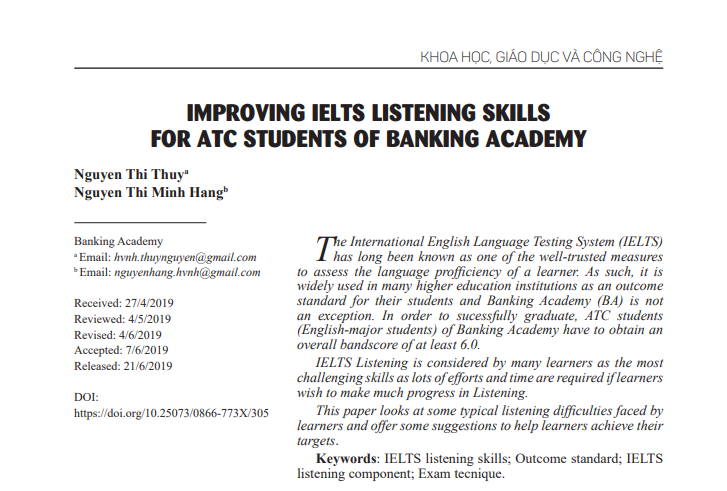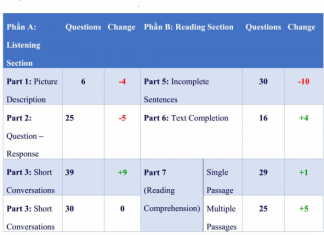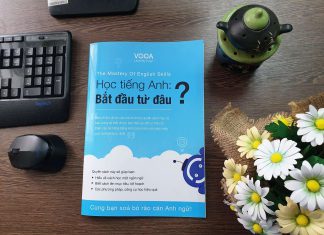Howatt and Dakin (1974) believe that listening refers to the ability of a person to identify and understand what others are saying and this is a procedure which requires the listener to be able to understand of the accent, pronunciation, grammar and vocabulary as well as comprehend the message delivered. And therefore a good listener is defined as the one who is capbable of doing these four thingssimultenously.
IELTS listening skills for ATC student of banking academy

1. Listening perspectives
1.1. Listening definitions
Thomlison’s (1984) definition of listening includes “active listening”, which goes beyond comprehending as understanfing the message content, to comprehension as an act of empathetic understanding of the speaker.
According to Hamouda (2013), listening comprehension is the ability to understand what the listener has been heard and repeat the text despite the fact that the listener may repeat the sounds without real comprehension.
1.2. Types of listening
According to Johna Kline (1996) there are five types of Listening
1.2.1. Informative listening
Informative listening refers to the situation where the utmost goal of the listener is to get the message delivered. This type of listening is found in all areas of our lives and much of our learning comes from informative listening. There are three key factors to help listeners be successful in understanding what the speaker means: vocabulary, concentration and memory.
1.2.2. Relationship listening
The purpose of relationship listening is either to help an individual or to improve the relationship between people. Therapeutic listening is a special type of relationship listening. Therapeutic listening brings to mind situations where counselors, medical personnel, or other professionals allow a troubled person to talk through a problem. Although relationship listening requires listeners to listen for information, the emphasis is on understanding the other person. Three behaviors are key to effective relationship listening: attending, supporting, and empathizing.
1.2.3. Appreciative listening
Appreciative listening refers to the situation when listeners listen for enjoyment, for example: listening to music or listening and watching films. As such, the focus is the response of the listener, not the information or the message and the effect of appreciative listening will not be the same for every listener. The quality of appreciative listening largely depends on three factors: presentation, per-ception, and previous experience.
1.2.4. Critical listening
Critical listening requires the listener to make judgement or response to the message they receive. In order to be an effective critical listener, one should be able to analyse the three elements of the message: ethos, or source credibility; logos, or logical argument; and pathos, or psychological appeals.
1.2.5. Discriminative listening
The final type of listening is also the most important one as it acts as a basis for the other four types. The focus of discriminative listening is on sounds and sound structures to get the true and intended meaning of the message.
2. Listening matters concerning IELTS listening tests
2.1. Listening in IELTS
2.1.1. Purpose of the testThe IELTS Listening test is designed to assess a variety of listening skills. In particular, it is to check how well listeners get main ideas and specific detailed information, how well they recognise the opinions, attitude and purpose of a speaker and to check if they can follow the development of argument.
There are a variety of question types including multiple choice questions, matching, short answer questions, sentence completion, form/table completion, labeling a map/diagram/plan, summary, and classification of information.
2.1.3. IELTS Listening exam techniques
2.2. Suggested in-class activities to enhance students’ IELTS Listening skills.
2.2.1. Pre-listening activities
The purposes of the pre-listening activities are to provide students with a clear context of what they are going to hear and to equip students with the topic vocabulary as well as the language structures in the recordings.
2.2.2. While –listening activities
Apart from the well-designed IELTS Listening practice tests that teachers can use in class, they can use other authentic materials and these activities to raise students’ interest in listening and to improve skills necessary for the IELTS Listening test such as: listening for the gist, listening for specific information and listening for speakers’ attitude or opinion.A gapped text: Teachers could give students a copy of a song lyrics with certain words blanked out. The first option is to let students predict the words that go into each blank. The second option is to give them suggested words and they then have to analyze the text in order to fill in the correct words. The third option is to give them synonyms/ paraphrases of the words needed for each blank and
they need to find out the correct words. Once they have done this, they listen to the song and check their answers.True/False statements: In this activity, students are required to watch a video clip and then determine whether the statements given are correct or not. It may be helpful if students underline keywords before they watch. Teachers could make use of videos (documentaries, news, weather forecast, interviews or inspiring speeches of famous people) available on the Internet to design the task. By using videos in their lessons, teachers can help students to retain more information, understand different concepts quicker and to make students
more interested in what they are listening to.Right words: Students are required to find mistakes in a song lyric or a video script. This activity focuses on the words that often make
students confuse when they listen like homophones (words that have the same pronunciation but different meanings or spelling or similar soundwords.
2.2.3. Post-listening activities
A post-listening activity act as a follow up to the main listening activity and aims to utilize the knowledge or vocabulary obtained from the listening.
3. Conclusion
In this paper, the authors have looked into theextent of IELTS Listening description, listening skill requirements and then give some suggestedin-class activities for teachers to perform well in listening class in order to enable their students toget the highest possible score in the test. Through this paper, the researcher believed that successful listening can only be acquired overtime and with continuous practice and teachers, with suitable teaching styles and teaching activities, can help students gradually become more confident in communication in general and in the IELTS listening component in particular.



























